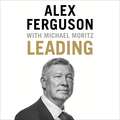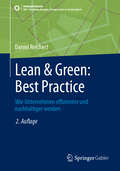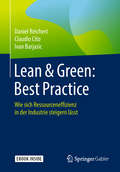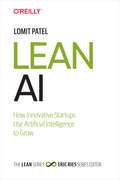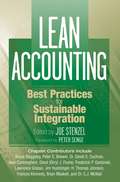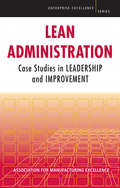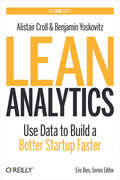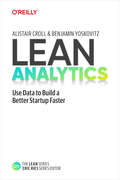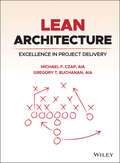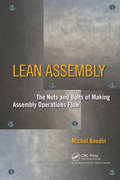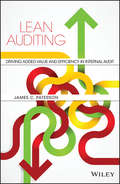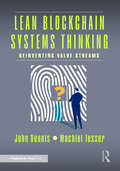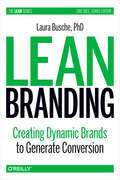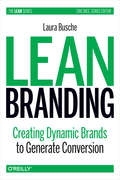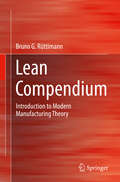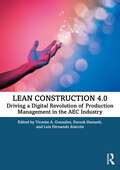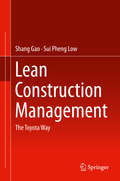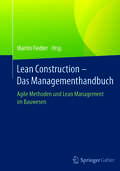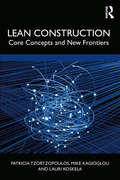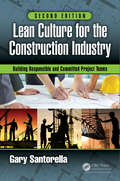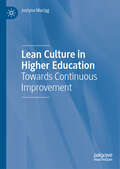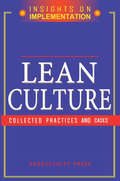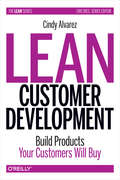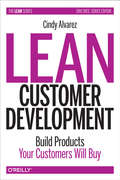- Table View
- List View
Leading: Lessons in leadership from the legendary Manchester United manager
by Alex FergusonWhat does it take to lead a team to world-class success over a sustained period of time?Sir Alex Ferguson is one of the few leaders who truly knows. In his 38 years in management, Sir Alex won an astonishing 49 trophies and helped grow Manchester United into one of the biggest commercial brands in the world. In this inspirational and straight-talking new book, Sir Alex reveals the secrets behind his record-breaking career.LEADING is structured around the key skills that Sir Alex values most highly. It includes subjects we immediately associate with his managerial style: Discipline, Control, Teamwork and Motivation. But it also addresses subjects that are less obvious but no less important when seeking success: Delegation, Data Analysis and Dealing with Failure.Written with the investor Sir Michael Moritz, a longstanding friend of Sir Alex, LEADING is packed with insight, wisdom, humour and honesty. The individual stories inevitably concern themselves with football, and the phenomenal success that came along the way, but the lessons can be applied by anyone. Whether you run a business, teach in a classroom, or work in a small team, LEADING will help you become a better leader.(P)2015 Hodder & Stoughton
Lean & Green: Wie Unternehmen effizienter und nachhaltiger werden (SDG - Forschung, Konzepte, Lösungsansätze zur Nachhaltigkeit)
by Daniel ReichertDieses Buch präsentiert Erfolgsrezepte führender europäischer Unternehmen, die durch Lean-Management und Nachhaltigkeitsstrategien Wettbewerbsvorteile erzielen. Die vorgestellten Unternehmen, Teilnehmer des Lean & Green Management Awards, demonstrieren, wie Effizienzsteigerung und ökologische sowie soziale Verantwortung Hand in Hand gehen können.In Zeiten wachsender Unsicherheiten, geprägt durch geopolitische Spannungen, regulatorische Anforderungen und Rohstoffknappheit, wird nachhaltige Wertschöpfung zum entscheidenden Erfolgsfaktor. Unternehmen, die Ressourceneffizienz systematisch steigern, senken nicht nur Kosten, sondern erhöhen ihre Widerstandsfähigkeit und Zukunftsfähigkeit.Das Konzept Lean & Green kombiniert schlanke, effiziente Prozesse mit Umwelt- und Nachhaltigkeitsaspekten, um Nachhaltigkeit messbar und operativ wirksam zu machen. Der Autor zeigt, wie Unternehmen Lean-Methoden gezielt für mehr Nachhaltigkeit nutzen können, um wirtschaftlichen Erfolg und ökologische Verantwortung zu vereinen. Praktische Anleitungen und Best-Practice-Beispiele bieten wertvolle Einblicke für Unternehmen, die ihre Wettbewerbsfähigkeit langfristig sichern wollen.
Lean & Green: Wie sich Ressourceneffizienz in der Industrie steigern lässt
by Daniel Reichert Claudio Cito Ivan BarjasicDas Buch stellt Erfolgsrezepte von europäischen Top-Unternehmen vor, die am Lean & Green Management Award teilgenommen haben. Es beschreibt die intelligente Verknüpfung von Lean-Management-Ansätzen mit Umwelt- und Energieaspekten. Dadurch können Kosten gesenkt und Nachhaltigkeitsstrategien operativ wirksamer gestalten werden. Im Fokus steht die Steigerung der Ressourceneffizienz eines Unternehmens.Die Bedeutung ressourceneffizienter Produktionsprozesse nimmt stetig zu und wird in Zukunft ein kritischer Erfolgsfaktor sein. Treiber dieser Entwicklung sind politische Rahmengesetzgebungen, bewusstere Konsumenten, Rohstoffknappheit und Kostendruck. Die zunehmende Anzahl an „grünen“ Produkten, Nachhaltigkeitsberichten und Marketinginitiativen belegen den Trend. Die operative Umsetzung von Ressourceneffizienz & Nachhaltigkeit ist allerding für viele Unternehmen noch schwierig. Sie sind deshalb auf innovative und effektive Methoden angewiesen. Die Autoren beschreiben den Nutzen von Lean & Green, stellen die Ansätze der Unternehmen vor, die bereits eine Vorreiterrolle beim Thema Ressourceneffizienz einnehmen und geben konkrete Handlungsanleitungen, wie sich die Ressourceneffizienz eines Unternehmens steigern lässt.
Lean AI: How Innovative Startups Use Artificial Intelligence to Grow
by Lomit PatelHow can startups successfully scale customer acquisition and revenue growth with a Lean team? Out-of-the-box acquisition solutions from Facebook, Google, and others provide a good start, but the companies that can tailor those solutions to meet their specific needs, objectives, and goals will come out winners. But that hasn’t been an easy task—until now.With this practical book, author Lomit Patel shows you how to use AI and automation to provide an operational layer atop those acquisition solutions to deliver amazing results for your company. You’ll learn how to adapt, customize, and personalize cross-channel user journeys to help your company attract and retain customers—to usher in the new age of Autonomous Marketing.Learn how AI and automation can support the customer acquisition efforts of a Lean StartupDive into Customer Acquisition 3.0, an initiative for gaining and retaining customersExplore ways to use AI for marketing purposesUnderstand the key metrics for determining the growth of your startupDetermine the right strategy to foster user acquisition in your companyManage the increased complexity and risk inherent in AI projects
Lean Accounting
by Joe StenzelPraise for Lean Accounting Best Practices for Sustainable Integration"Anyone involved in a lean transformation inevitably bumps up against the vagaries of the accounting systems that reward overproduction and waste and seem to punish true improvement. We wonder what would happen if the accountants actually came to the production floor and witnessed firsthand the havoc created by their systems. This volume gathers together some of the best thinkers to take a critical look at traditional cost accounting and defines a path forward to 'lean accounting.'"--Jeff Liker, Professor of Industrial and Operations Engineering, University of Michigan"Joe Stenzel has put together a timely compendium of writings from thought leaders in lean accounting. The viewpoints in this fine book are diverse and yet proclaim a consistent message: that conventional management accounting is broken--and here is how to fix it."--Richard J. Schonberger, President, Schonberger & Associates"If you are serious about understanding and implementing Lean Accounting in conjunction with your Lean Enterprise journey, this book will illuminate the specific techniques, but more importantly, will explain the cultural changes that are a prerequisite for success."--Jerry Solomon, Vice President of Operations, Hunt Valley, for MarquipWardUnited, a division of Barry-Wehmiller Companies, Inc.Insights and strategies from the most experienced lean accounting and performance measurement?practitioners in AmericaLearn how to integrate the proven lean methodologies embedded in the Toyota Production System with Lean Accounting: Best Practices for Sustainable Integration. In this comprehensive guide, leading accounting and performance measurement practitioners analyze the current business climate and provide CFOs and accounting/finance personnel with step-by-step guidelines to seamlessly and successfully integrate sustainable, lean accounting principles within their enterprise.Be a lean success story with Lean Accounting.
Lean Administration: Case Studies in Leadership and Improvement
by Association for Manufacturing ExcellenceAME's Target Magazine has a well-established reputation for detailed case studies of companies adopting lean strategies. These case studies are now available in a well-organized Enterprise Excellence Series, to tap the ongoing desire for information about what other companies are doing to implement lean. To satisfy the growing interest in applying lean to non-manufacturing operations, this first volume of the series covers the implementation of lean to administrative and office applications. Highlights include: Practical, in-depth description of lean office implementations, most of which have not been described in other publications. Responds to reader desire for real-world lean office information. Case Studies are categorized in three areas: Leadership, Organization and Training; Improving Processes; and Lean in Healthcare, making it easy to track down the type of information desired.
Lean Analytics: Use Data to Build a Better Startup Faster
by Alistair Croll Benjamin YoskovitzWhether you're a startup founder trying to disrupt an industry or an intrapreneur trying to provoke change from within, your biggest challenge is creating a product people actually want. Lean Analytics steers you in the right direction. This book shows you how to validate your initial idea, find the right customers, decide what to build, how to monetize your business, and how to spread the word. Packed with more than thirty case studies and insights from over a hundred business experts, Lean Analytics provides you with hard-won, real-world information no entrepreneur can afford to go without. Understand Lean Startup, analytics fundamentals, and the data-driven mindset Look at six sample business models and how they map to new ventures of all sizes Find the One Metric That Matters to you Learn how to draw a line in the sand, so you'll know it's time to move forward Apply Lean Analytics principles to large enterprises and established products
Lean Analytics: Use Data to Build a Better Startup Faster
by Alistair Croll Benjamin YoskovitzWhether you're a startup founder trying to disrupt an industry or an entrepreneur trying to provoke change from within, your biggest challenge is creating a product people actually want. Lean Analytics steers you in the right direction.This book shows you how to validate your initial idea, find the right customers, decide what to build, how to monetize your business, and how to spread the word. Packed with more than thirty case studies and insights from over a hundred business experts, Lean Analytics provides you with hard-won, real-world information no entrepreneur can afford to go without.Understand Lean Startup, analytics fundamentals, and the data-driven mindsetLook at six sample business models and how they map to new ventures of all sizesFind the One Metric That Matters to youLearn how to draw a line in the sand, so you'll know it's time to move forwardApply Lean Analytics principles to large enterprises and established products
Lean Architecture: Excellence in Project Delivery
by Michael F. Czap Gregory T. BuchananApply lean principles to your next architectural project and improve your bottom line with the help of this practical volume Lean Architecture: Excellence in Project Delivery shows readers a path to consistently achieve excellence in project delivery via the application of lean concepts and process management. Authors Michael Czap and Gregory Buchanan challenge readers to reexamine their approach to architectural practice and projects by presenting a unique and compelling alternative. Lean Architecture details the crucial metrics and implementation strategies that combine to improve the efficiency and profitability of projects taken on by firms of all sizes. Readers of the book will learn to: Maximize the use of their resources to deliver superior results in less time Minimize waste, cost, and inefficiency in their firm’s operations Move between radically different project scales while retaining efficient and effective processes Lean Architecture is perfect for firm leaders, project managers, and project architects who seek to improve their ability to deliver better results while reducing their cost base.
Lean Assembly: The Nuts and Bolts of Making Assembly Operations Flow
by Michel BaudinWith examples drawn from aerospace, electronics, household appliance, personal products, and automotive industries, Lean Assembly covers the engineering of assembly operations through:Characterizing the demand in terms of volume by product and product family, component consumption, seasonal variability and life cycle.Matching the physical structure of the shop floor to the demand with the goal of approaching takt-driven production as closely as possible.Working out the details of assembly tasks station by station, including station sizing, tooling, fixturing, operator instructions, part presentation, conveyance between stations, and the geometry of assembly lines as a whole.Incorporating mistake-proofing, successive inspection, and test operations for quality assurance.Lean Assembly differs from most other books on lean manufacturing in that it focuses on technical content as a driver for implementation methods. The emphasis is on exactly what should be done. This book should be the "dog-eared" and "penciled-in" resource on every assembly engineer's desk.
Lean Auditing
by James C. Paterson"How can you argue with the core principles of Lean, that you focus on what provides value to your customer and eliminate work that is not necessary (muda)? Internal auditors need to understand not only who their primary customers are, but what is valuable to them - which in most cases is assurance that the risks that matter to the achievement of objectives are properly managed. We need to communicate what they need to know and not what we want to say. This incessant focus on the customer and the efficient production of a valued product should extend to every internal audit team. How else can we ensure that we optimize the use of our limited resources to address the dynamic business and risk environment within which our organizations operate?"Norman Marks, GRC Thought LeaderUsing lean techniques to enhance value add and reduce waste in internal auditingLean Auditing is a practical guide to maximising value and efficiency in internal audit through the application of lean techniques. It is an ideal book for anyone interested in understanding what progressive, value adding audit can be like. It is also ideal for anyone wondering whether audit activities can be streamlined or better co-ordinated with other activities.The book contains practical advise from the author's experience as CAE of AstraZeneca PLC; from his work as a consultant specializing in this field; as well as insights from leading CAEs in the UK, US and elsewhere. In addition, there are important insights from thought leaders such as Richard Chambers (IIA US) and Norman Marks (GRC thought leader) and Chris Baker (Technical Manager of the IIA UK).Increasing pressure on resources is driving a need for greater efficiency in all areas of business, and Internal Audit is no exception. Lean techniques can help streamline the workflow, but having only recently been applied to IA, lack the guidance available for other techniques. Lean Auditing fills this need by combining expert instruction and actionable advice that helps Internal Auditors:Benchmark their efficiency against lean ways of workingUnderstand warning signs of waste and lower added valueUnderstanding practical ways of working that improve added value and reduce wasteGain confidence about progressive ways of working in internal auditUnderstand how improved ways of working in audit can positively impact the culture of the wider organizationOne of the keys to the lean audit is finding out exactly what the stakeholder wants, and eliminating everything else. Scaling back certain operations can delineate audit from advisory, and in the process, dramatically improve crucial outcomes. To this end, Lean Auditing is the key to IA efficiency.
Lean Blockchain Systems Thinking: Reinventing Value Streams
by John Dennis Machiel TesserThis book brilliantly illustrates how blockchain and Web3 are revolutionizing value exchange in society. Blockchain technology sets new standards for transparency, provenance, and traceability, benefiting every stakeholder across the value chain in an interoperable manner. The technology fundamentally transforms industries, verticals, and functions within organizations, enabling decentralized identity, asset tokenization, governance, and enhanced privacy. This book offers a deep yet accessible guide to navigating this new paradigm.—Alejandro Acuña Rodríguez, Blockchain Infrastructure Specialist, CrossmintLean Thinking has its roots in ideas developed for process improvement in the 1900s. Systems Thinking was discussed as far back as the 1950s. Blockchain technology is based on work that started in the 1990s and was implemented soon after Satoshi Nakamoto published his Bitcoin whitepaper in 2009. Together, these three components—Lean, Blockchain, and Systems Thinking—provide a revolutionary force in process management efficiency and effectiveness.This book provides a perspective on the advantages of blockchain technology that is rarely covered in business books as well as specialist blockchain-related content. The focus has been the use of Cryptocurrencies as a store of financial value and as an instrument of speculation, like the stock market. This book shows that blockchain, together with Lean and Systems Thinking can provide multiple advantages for societies and the environment. It can be used effectively to meet sustainable development goals (SDGs).Readers will appreciate that blockchain within Lean practices and Systems Thinking opens opportunities for fundamental organizational transformation, improved strategic decision-making, increased interoperability, and a fairer, more sustainable, and less wasteful world. This book clarifies how the integration of blockchain technology as an organizational concept integrates Lean principles and Systems Thinking. This brings a transformative shift in process design, increasing productivity while minimizing waste across sectors such as industry, public services, governance, supply chains, and social frameworks.
Lean Branding: Creating Dynamic Brands to Generate Conversion
by Laura BuscheEvery day, thousands of passionate developers come up with new startup ideas but lack the branding know-how to make them thrive. If you count yourself among them, Lean Branding is here to help.This practical toolkit helps you build your own robust, dynamic brands that generate conversion. You’ll find over 100 DIY branding tactics and inspiring case studies, and step-by-step instructions for building and measuring 25 essential brand strategy ingredients, from logo design to demo-day pitches, using The Lean Startup methodology’s Build-Measure-Learn loop.Learn exactly what a brand is—and what it isn’tBuild a minimal set of brand ingredients that are viable in the marketplace: brand story, brand symbols, and brand strategyMeasure your brand ingredients by using meaningful metrics to see if they meet your conversion goalsPivot your brand ingredients in new directions based on what you’ve learned—by optimizing rather than trashingFocus specifically on brand story, symbols, or strategy by following the Build-Measure-Learn chapters that apply
Lean Branding: Creating Dynamic Brands to Generate Conversion (Lean (o'reilly) Ser.)
by Laura BuscheEvery day, thousands of passionate developers come up with new startup ideas but lack the branding know-how to make them thrive. If you count yourself among them, Lean Branding is here to help.This practical toolkit helps you build your own robust, dynamic brands that generate conversion. You’ll find over 100 DIY branding tactics and inspiring case studies, and step-by-step instructions for building and measuring 25 essential brand strategy ingredients, from logo design to demo-day pitches, using The Lean Startup methodology’s Build-Measure-Learn loop.Learn exactly what a brand is—and what it isn’tBuild a minimal set of brand ingredients that are viable in the marketplace: brand story, brand symbols, and brand strategyMeasure your brand ingredients by using meaningful metrics to see if they meet your conversion goalsPivot your brand ingredients in new directions based on what you’ve learned—by optimizing rather than trashingFocus specifically on brand story, symbols, or strategy by following the Build-Measure-Learn chapters that apply
Lean Compendium
by Bruno G. RüttimannThe book covers basic manufacturing theory and develops a Cartesian approach to explaining lean. It provides a structured fundament how a lean manufacturing system works. Students get a consistent approach, explaining lean by increased complexity (mono-product, multi-product, complex manufacturing systems) with theorems, corollaries, and lemmas. Instructors get explanations for lean based on a systemic model, helping to transmit a clear view about the theory of lean.
Lean Construction 4.0: Driving a Digital Revolution of Production Management in the AEC Industry
by Vicente A. González Farook Hamzeh Luis Fernando AlarcónThis book introduces and develops the novel concept of Lean Construction 4.0. The capability of Lean Construction to effectively adapt the architecture-engineering-construction (AEC) industry to this new era of digital transformation requires a reconceptualization of the triad people-processes-technology as a foundation for the theoretical and practical framework of Lean Construction. Therefore, a shift towards Lean Construction 4.0 is required. Lean Construction 4.0 is a new systems-wide thinking approach where synergies and overlaps between Lean Construction and digital/smart technologies go far beyond BIM to reshape the way we design, manage, and operate capital projects in the modern age of automation. This pioneering new book brings together the views of world experts at the interface of Lean Construction and digital/smart technologies, in order to channel research efforts, to introduce and discuss current research and practice, challenges and drivers, and future perspectives of Lean Construction 4.0. It is not the aim of the book to keep adding digits to the term ‘Lean Construction’ to ‘catch up’ with the industry revolutions as they go on. Instead, after reading this book, it will be undeniable for readers that the triad process-people-technology as proposed by Lean Construction 4.0 is required to achieve an effective, long-lasting digital transformation of the AEC industry. Thus, the aim of Lean Construction 4.0 is better explained by what it evokes: a future vision of construction systems comprising people, processes, and technology using Industry 4.0/5.0 as a basis for technological innovation in the AEC industry coupled with Lean Construction theory and practice as a jettison for improved processes and systems integration. The Lean Construction 4.0 concept coined and developed in this edited book is unique and the chapters provide practitioners and academics with a provocative reflection on the theoretical and practical aspects that shape the Lean Construction 4.0 concept. More importantly, Lean Construction 4.0 proposes a rationale for the AEC industry not only to survive, but to thrive!
Lean Construction Management
by Sui Pheng Low Shang GaoThe book presents a mixed research method adopted to assess and present the Toyota Way practices within construction firms in general and for firms in China specifically. The results of an extensive structured questionnaire survey based on the Toyota Way-styled attributes identified were developed and data collected from building professionals working in construction firms is presented. The quantitative data presented in the book explains the status quo of the Toyota Way-styled practices implemented in the construction industry, as well as the extent to which these attributes were perceived for lean construction management. The book highlights all the actionable attributes derived from the Toyota Way model appreciated by the building professionals, but alerts the readers that some attributes felled short of implementation. Further findings from in-depth interviews and case studies are also presented in the book to provide to readers an understanding how these Toyota Way practices can be implemented in real-life projects. Collectively, all the empirical findings presented in this book can serve to enhance understanding of Toyota Way practices in the lean construction management context. The readers are then guided through to understand the gaps between actual practice and Toyota Way-styled practices, and the measures that they may undertake to circumvent the challenges for implementation. The book also presents to readers the SWOT analysis that addresses the strengths, weaknesses, opportunities and threats towards the implementation of the Toyota Way in the construction industry. The book prescribes the Toyota Way model for use in construction firms to strategically implement lean construction management. The checklist presented in the book enables readers to draw lessons that may be used additionally as a holistic assessment tool for measuring the maturity of firms with respect to their Toyota Way implementation. Consequent to this, management would then be in a better position to develop plans for Toyota Way implementation by focusing on weak areas, strengthening them, and thus increasing the likelihood of success in the implementation of the Toyota Way. In a nutshell, this book provides a comprehensive and valuable resource for firms not only in the construction industry but also businesses outside of the construction sector to better understand the Toyota Way and how this understanding can translate to implementation of lean construction/business management to enhance profitability and survivability in an increasingly competitive global market place.
Lean Construction – Das Managementhandbuch: Agile Methoden und Lean Management im Bauwesen
by Martin FiedlerDieses Buch liefert einen Einblick in neue Methoden f#65533;r das Management von Bauprojekten. Gerade bei Gro#65533;projekten besteht Gefahr, dass Termine, Kosten und Qualit#65533;t nicht eingehalten werden. Komplexe Bauvorhaben geh#65533;ren zu dieser Projektkategorie und bed#65533;rfen einer speziellen Steuerung. Dieses Buch gibt durch Beispiele aus Gro#65533;projekten und unternehmensweiten Einf#65533;hrungen von Lean Management im Bauwesen einen tieferen Einblick in die Thematik. Lean Construction verspricht allen Beteiligten eines Bauprojektes, dass in der Planung und w#65533;hrend der Bauphase definierte Parameter eingehalten werden. Dieses Buch wendet sich insbesondere an Bauabteilungen der Industrie, Bautr#65533;ger und private Bauherren sowie Beteiligte eines Bauprojektes wie Architekten, Ingenieure und Projektverantwortliche, die mit Lean Construction eine nachhaltige Verbesserung der Planungs- und Umsetzungsphase erreichen wollen.
Lean Construction: Core Concepts and New Frontiers
by Michail Kagioglou Patricia Tzortzopoulos Lauri KoskelaThis book collates the main research developments around Lean Construction over the past 25 years with contributions from many seminal authors in the field. It takes stock of developments since the publication of Koskela’s (1992) Application of the New Production Philosophy to Construction and, in doing so, challenges current thinking and progress. It also crystallises theoretical conceptualisations and practically situated learning whilst identifying future research challenges, agendas and opportunities for global collaborative actions. The contributors present the development of Lean Construction as a fundamental part of improving construction productivity, quality and delivery of value to clients and users of built infrastructure. In doing so, the book introduces the reader to the foundational principles and theories that have influenced the way we now understand Lean Construction and has provided very useful insights to students, practitioners and researchers on key junctures over the last 25 years. Highlighting the key contemporary developments and using global case study material the chapters demonstrate good practice but also help introduce new thinking to both lay readers and experienced practitioners alike. This book is essential reading for undergraduate and postgraduate students, researchers and practitioners with an interest in Lean Construction and construction management, providing a general understanding of the area, current state of the art knowledge as well as providing an insight into areas for future research.
Lean Culture for the Construction Industry: Building Responsible and Committed Project Teams, Second Edition
by Gary SantorellaMany of the struggles that we are currently experiencing when attempting to implement Lean in the construction environment are the direct result of applying Lean tools out of proper context. Understanding Lean as an overall operating system will help to avert this all too common pitfall. An in-depth exploration of the application of Lean initiatives in the construction industry, Lean Culture for the Construction Industry: Building Responsible and Committed Project Teams, Second Edition provides updated chapters with new insights on the relationships between owners, architects, general contractors and subcontractors - demonstrating how Kaizan events focused on building positive culture through vulnerability-based trust improved processes and eliminated work stoppages. Lean tools alone don't lead to successful Lean initiatives: the missing piece is culture. Written by a veteran consultant in the construction field, the book draws a connection between how construction professionals act as leaders and how their attitude and behavior affect productivity and waste daily. While value stream mapping is an important tool for righting broken processes and resolving conflicts, future state maps will fail if leaders continue to work in silos, protect their territories, and don't see that their success is directly tied to the success of their co-leaders. The author expands the notion of ethics beyond the simple litmus test of right and wrong, so team leaders can adopt professional and productive attitudes and behaviors toward the implementation of Lean improvements. This book demonstrates how, in an industry where waste is rampant, and depends on wide range of people and personalities to successfully build a job, Lean thinking can make the difference between a profitable, competitive construction team, and mass inefficiencies, stunted profitability, and lost future opportunities.
Lean Culture in Higher Education: Towards Continuous Improvement
by Justyna MaciągThis book deepens the understanding of cultural conditions for implementing organizational and process changes in higher education institutions. Developing the humanistic and critical trend in Lean management research, it aims to define the notion and maturity of a Lean culture in higher education institutions as well as to determine its key dimensions and descriptions in the light of adopted ontological and epistemological assumptions. This book defines the notion of Lean Culture, proposes a model to assess its maturity, determines conditions for its implementation, and presents the tools of the Lean management model in a university. It supplements the issues related to the implementation of the Lean concept by adopting a humanistic approach.
Lean Culture: Collected Practices and Cases
by Productivity Press Development TeamThe hard part of implementing a lean transformation, according to most experts, is dealing with the "soft" issues, such as culture change. Getting employees to live and breathe lean -- actively supporting and buying into lean concepts and philosophy, always searching for ways to eliminate waste, and continuously improving processes and providing greater value for customers -- is the real challenge when building and sustaining a lean culture.Lean Culture: Collected Practices and Cases provides a variety of case studies taken from articles previously published in Lean Manufacturer Advisor: the monthly newsletter by Productivity Press. All focus on cultural issues, ranging from the role of top management, to training and development of workers and managers, to building buy-in and to sustaining the culture.Highlights include: Practical, in-depth descriptions of cultural issues in a lean transformation, written in a conversational, easy-to-read style.Many case studies unavailable from any other single source.Articles categorized by specific area - all desired information is easily located.Real-world information about culture change collected in one handy book.
Lean Customer Development
by Cindy AlvarezHow do you develop products that people will actually use and buy? This practical guide shows you how to validate product and company ideas through customer development research--before you waste months and millions on a product or service that no one needs or wants.With a combination of open-ended interviewing and fast and flexible research techniques, you'll learn how your prospective customers behave, the problems they need to solve, and what frustrates and delights them. These insights may shake your assumptions, but they'll help you reach the "ah-ha!" moments that inspire truly great products.Validate or invalidate your hypothesis by talking to the right peopleLearn how to conduct successful customer interviews play-by-playDetect a customer's behaviors, pain points, and constraintsTurn interview insights into Minimum Viable Products to validate what customers will use and buyAdapt customer development strategies for large companies, conservative industries, and existing products
Lean Customer Development: Building Products Your Customers Will Buy
by Cindy AlvarezHow do you develop products that people will actually use and buy? This practical guide shows you how to validate product and company ideas through customer development research—before you waste months and millions on a product or service that no one needs or wants.With a combination of open-ended interviewing and fast and flexible research techniques, you’ll learn how your prospective customers behave, the problems they need to solve, and what frustrates and delights them. These insights may shake your assumptions, but they’ll help you reach the "ah-ha!" moments that inspire truly great products.Validate or invalidate your hypothesis by talking to the right peopleLearn how to conduct successful customer interviews play-by-playDetect a customer’s behaviors, pain points, and constraintsTurn interview insights into Minimum Viable Products to validate what customers will use and buyAdapt customer development strategies for large companies, conservative industries, and existing products
Lean Customer Development: Building Products Your Customers Will Buy
by Cindy AlvarezHow do you develop products that people will actually use and buy? This practical guide shows you how to validate product and company ideas through customer development research—before you waste months and millions on a product or service that no one needs or wants.With a combination of open-ended interviewing and fast and flexible research techniques, you’ll learn how your prospective customers behave, the problems they need to solve, and what frustrates and delights them. These insights may shake your assumptions, but they’ll help you reach the "ah-ha!" moments that inspire truly great products.Validate or invalidate your hypothesis by talking to the right peopleLearn how to conduct successful customer interviews play-by-playDetect a customer’s behaviors, pain points, and constraintsTurn interview insights into Minimum Viable Products to validate what customers will use and buyAdapt customer development strategies for large companies, conservative industries, and existing products
